Road Pavement: A Literature Review on Building Waste Aggregate Use
VerifiedAdded on 2023/06/10
|14
|4202
|358
Literature Review
AI Summary
This literature review explores the feasibility and advantages of using building waste aggregate in road pavement to manage construction and demolition waste. It emphasizes the increasing need for recycling due to landfill capacity issues and environmental concerns. The review discusses the technical viability of using recycled aggregates as a base pavement layer, highlighting the simplicity of extracting cement concrete from building wastes and the importance of proper recycling techniques. It also addresses the environmental benefits, such as preserving natural resources and reducing waste accumulation. The process of recycling construction waste involves on-site separation and efficient design, which can reduce costs and promote sustainability. The review further examines the use of recycled materials like coarse and fine aggregates, reclaimed Portland cement concrete, and asphaltic concrete in road pavement, providing an effective solution to pollution and waste disposal problems. The use of bottom ash and fly ash is also discussed for various layers of pavement construction.
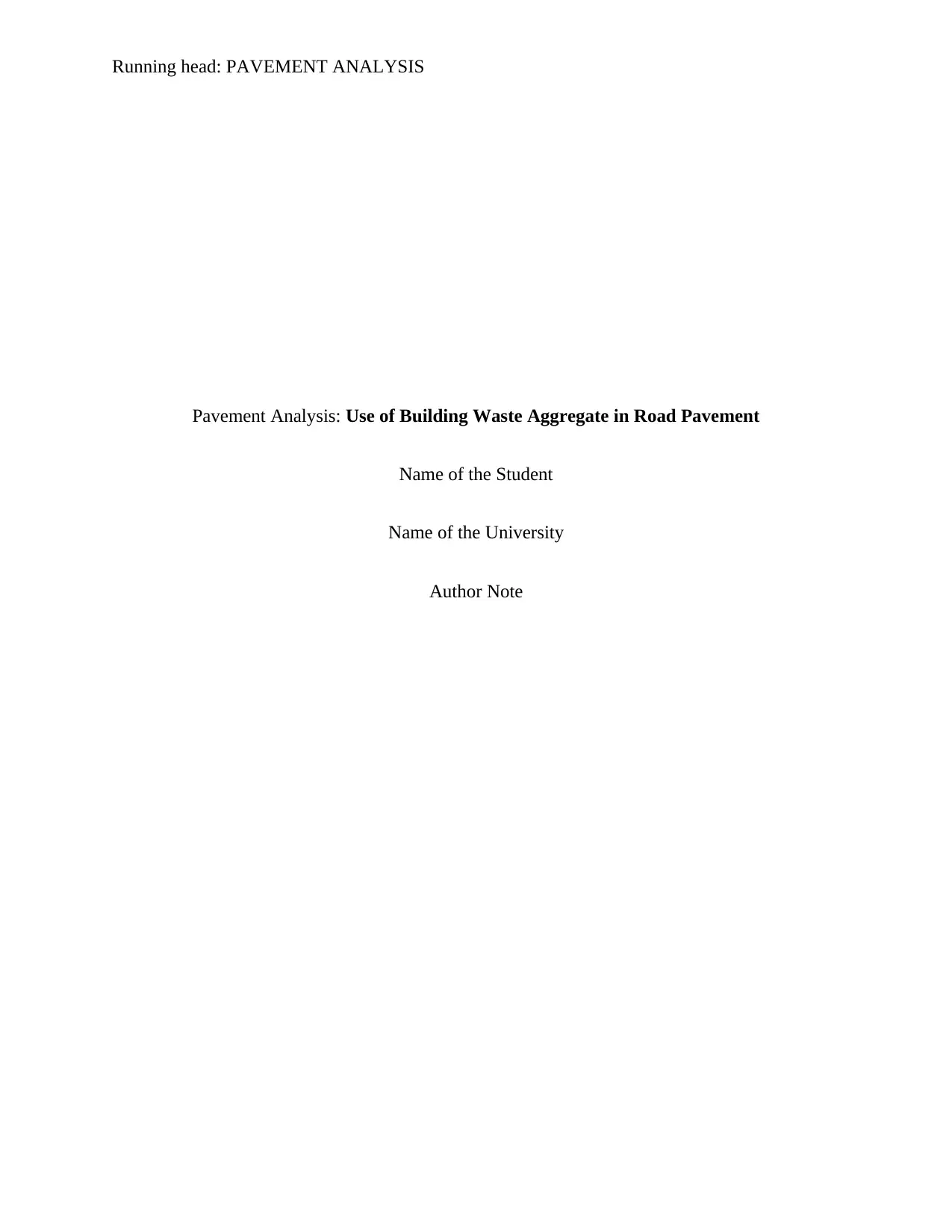
Running head: PAVEMENT ANALYSIS
Pavement Analysis: Use of Building Waste Aggregate in Road Pavement
Name of the Student
Name of the University
Author Note
Pavement Analysis: Use of Building Waste Aggregate in Road Pavement
Name of the Student
Name of the University
Author Note
Paraphrase This Document
Need a fresh take? Get an instant paraphrase of this document with our AI Paraphraser
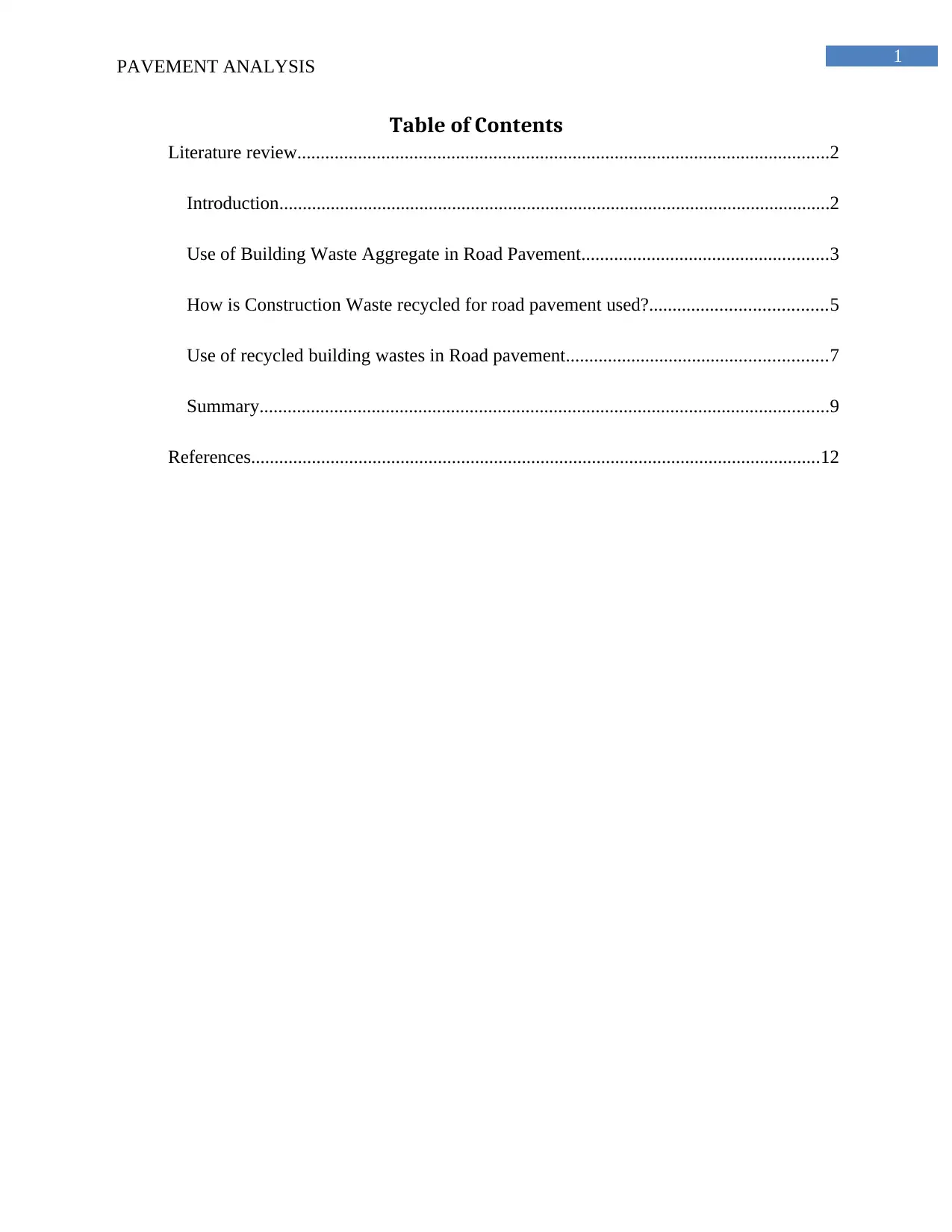
1
PAVEMENT ANALYSIS
Table of Contents
Literature review..................................................................................................................2
Introduction......................................................................................................................2
Use of Building Waste Aggregate in Road Pavement.....................................................3
How is Construction Waste recycled for road pavement used?......................................5
Use of recycled building wastes in Road pavement........................................................7
Summary..........................................................................................................................9
References..........................................................................................................................12
PAVEMENT ANALYSIS
Table of Contents
Literature review..................................................................................................................2
Introduction......................................................................................................................2
Use of Building Waste Aggregate in Road Pavement.....................................................3
How is Construction Waste recycled for road pavement used?......................................5
Use of recycled building wastes in Road pavement........................................................7
Summary..........................................................................................................................9
References..........................................................................................................................12
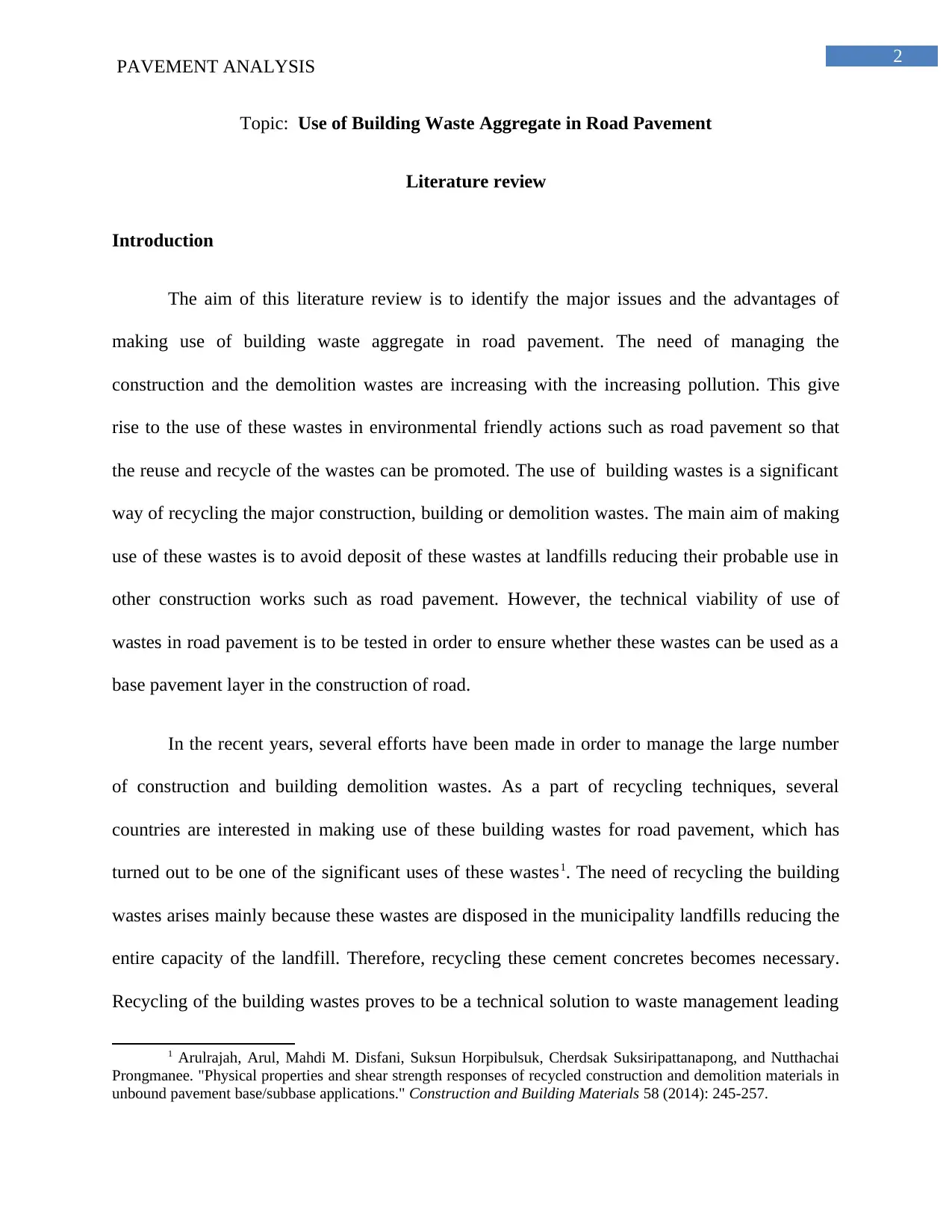
2
PAVEMENT ANALYSIS
Topic: Use of Building Waste Aggregate in Road Pavement
Literature review
Introduction
The aim of this literature review is to identify the major issues and the advantages of
making use of building waste aggregate in road pavement. The need of managing the
construction and the demolition wastes are increasing with the increasing pollution. This give
rise to the use of these wastes in environmental friendly actions such as road pavement so that
the reuse and recycle of the wastes can be promoted. The use of building wastes is a significant
way of recycling the major construction, building or demolition wastes. The main aim of making
use of these wastes is to avoid deposit of these wastes at landfills reducing their probable use in
other construction works such as road pavement. However, the technical viability of use of
wastes in road pavement is to be tested in order to ensure whether these wastes can be used as a
base pavement layer in the construction of road.
In the recent years, several efforts have been made in order to manage the large number
of construction and building demolition wastes. As a part of recycling techniques, several
countries are interested in making use of these building wastes for road pavement, which has
turned out to be one of the significant uses of these wastes1. The need of recycling the building
wastes arises mainly because these wastes are disposed in the municipality landfills reducing the
entire capacity of the landfill. Therefore, recycling these cement concretes becomes necessary.
Recycling of the building wastes proves to be a technical solution to waste management leading
1 Arulrajah, Arul, Mahdi M. Disfani, Suksun Horpibulsuk, Cherdsak Suksiripattanapong, and Nutthachai
Prongmanee. "Physical properties and shear strength responses of recycled construction and demolition materials in
unbound pavement base/subbase applications." Construction and Building Materials 58 (2014): 245-257.
PAVEMENT ANALYSIS
Topic: Use of Building Waste Aggregate in Road Pavement
Literature review
Introduction
The aim of this literature review is to identify the major issues and the advantages of
making use of building waste aggregate in road pavement. The need of managing the
construction and the demolition wastes are increasing with the increasing pollution. This give
rise to the use of these wastes in environmental friendly actions such as road pavement so that
the reuse and recycle of the wastes can be promoted. The use of building wastes is a significant
way of recycling the major construction, building or demolition wastes. The main aim of making
use of these wastes is to avoid deposit of these wastes at landfills reducing their probable use in
other construction works such as road pavement. However, the technical viability of use of
wastes in road pavement is to be tested in order to ensure whether these wastes can be used as a
base pavement layer in the construction of road.
In the recent years, several efforts have been made in order to manage the large number
of construction and building demolition wastes. As a part of recycling techniques, several
countries are interested in making use of these building wastes for road pavement, which has
turned out to be one of the significant uses of these wastes1. The need of recycling the building
wastes arises mainly because these wastes are disposed in the municipality landfills reducing the
entire capacity of the landfill. Therefore, recycling these cement concretes becomes necessary.
Recycling of the building wastes proves to be a technical solution to waste management leading
1 Arulrajah, Arul, Mahdi M. Disfani, Suksun Horpibulsuk, Cherdsak Suksiripattanapong, and Nutthachai
Prongmanee. "Physical properties and shear strength responses of recycled construction and demolition materials in
unbound pavement base/subbase applications." Construction and Building Materials 58 (2014): 245-257.
⊘ This is a preview!⊘
Do you want full access?
Subscribe today to unlock all pages.

Trusted by 1+ million students worldwide
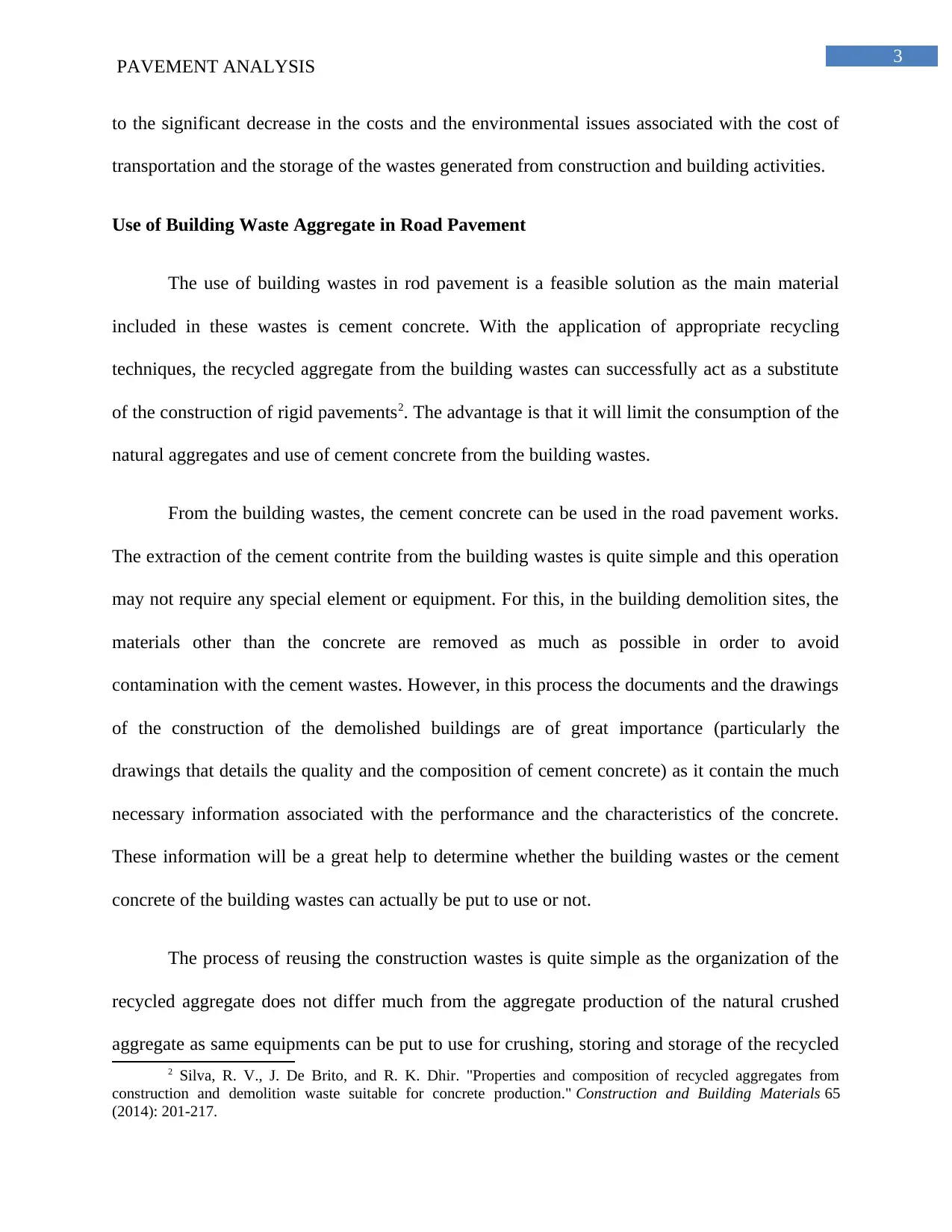
3
PAVEMENT ANALYSIS
to the significant decrease in the costs and the environmental issues associated with the cost of
transportation and the storage of the wastes generated from construction and building activities.
Use of Building Waste Aggregate in Road Pavement
The use of building wastes in rod pavement is a feasible solution as the main material
included in these wastes is cement concrete. With the application of appropriate recycling
techniques, the recycled aggregate from the building wastes can successfully act as a substitute
of the construction of rigid pavements2. The advantage is that it will limit the consumption of the
natural aggregates and use of cement concrete from the building wastes.
From the building wastes, the cement concrete can be used in the road pavement works.
The extraction of the cement contrite from the building wastes is quite simple and this operation
may not require any special element or equipment. For this, in the building demolition sites, the
materials other than the concrete are removed as much as possible in order to avoid
contamination with the cement wastes. However, in this process the documents and the drawings
of the construction of the demolished buildings are of great importance (particularly the
drawings that details the quality and the composition of cement concrete) as it contain the much
necessary information associated with the performance and the characteristics of the concrete.
These information will be a great help to determine whether the building wastes or the cement
concrete of the building wastes can actually be put to use or not.
The process of reusing the construction wastes is quite simple as the organization of the
recycled aggregate does not differ much from the aggregate production of the natural crushed
aggregate as same equipments can be put to use for crushing, storing and storage of the recycled
2 Silva, R. V., J. De Brito, and R. K. Dhir. "Properties and composition of recycled aggregates from
construction and demolition waste suitable for concrete production." Construction and Building Materials 65
(2014): 201-217.
PAVEMENT ANALYSIS
to the significant decrease in the costs and the environmental issues associated with the cost of
transportation and the storage of the wastes generated from construction and building activities.
Use of Building Waste Aggregate in Road Pavement
The use of building wastes in rod pavement is a feasible solution as the main material
included in these wastes is cement concrete. With the application of appropriate recycling
techniques, the recycled aggregate from the building wastes can successfully act as a substitute
of the construction of rigid pavements2. The advantage is that it will limit the consumption of the
natural aggregates and use of cement concrete from the building wastes.
From the building wastes, the cement concrete can be used in the road pavement works.
The extraction of the cement contrite from the building wastes is quite simple and this operation
may not require any special element or equipment. For this, in the building demolition sites, the
materials other than the concrete are removed as much as possible in order to avoid
contamination with the cement wastes. However, in this process the documents and the drawings
of the construction of the demolished buildings are of great importance (particularly the
drawings that details the quality and the composition of cement concrete) as it contain the much
necessary information associated with the performance and the characteristics of the concrete.
These information will be a great help to determine whether the building wastes or the cement
concrete of the building wastes can actually be put to use or not.
The process of reusing the construction wastes is quite simple as the organization of the
recycled aggregate does not differ much from the aggregate production of the natural crushed
aggregate as same equipments can be put to use for crushing, storing and storage of the recycled
2 Silva, R. V., J. De Brito, and R. K. Dhir. "Properties and composition of recycled aggregates from
construction and demolition waste suitable for concrete production." Construction and Building Materials 65
(2014): 201-217.
Paraphrase This Document
Need a fresh take? Get an instant paraphrase of this document with our AI Paraphraser
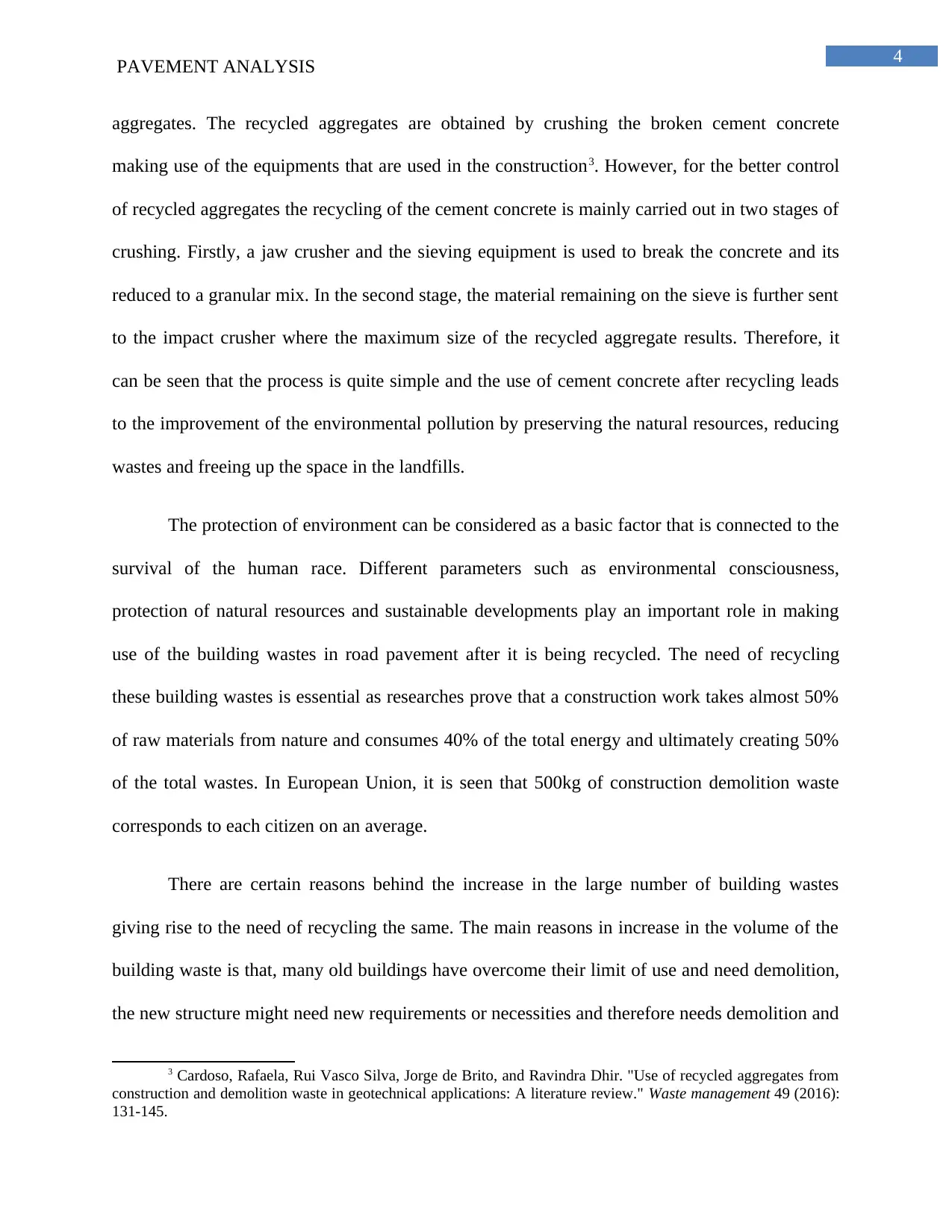
4
PAVEMENT ANALYSIS
aggregates. The recycled aggregates are obtained by crushing the broken cement concrete
making use of the equipments that are used in the construction3. However, for the better control
of recycled aggregates the recycling of the cement concrete is mainly carried out in two stages of
crushing. Firstly, a jaw crusher and the sieving equipment is used to break the concrete and its
reduced to a granular mix. In the second stage, the material remaining on the sieve is further sent
to the impact crusher where the maximum size of the recycled aggregate results. Therefore, it
can be seen that the process is quite simple and the use of cement concrete after recycling leads
to the improvement of the environmental pollution by preserving the natural resources, reducing
wastes and freeing up the space in the landfills.
The protection of environment can be considered as a basic factor that is connected to the
survival of the human race. Different parameters such as environmental consciousness,
protection of natural resources and sustainable developments play an important role in making
use of the building wastes in road pavement after it is being recycled. The need of recycling
these building wastes is essential as researches prove that a construction work takes almost 50%
of raw materials from nature and consumes 40% of the total energy and ultimately creating 50%
of the total wastes. In European Union, it is seen that 500kg of construction demolition waste
corresponds to each citizen on an average.
There are certain reasons behind the increase in the large number of building wastes
giving rise to the need of recycling the same. The main reasons in increase in the volume of the
building waste is that, many old buildings have overcome their limit of use and need demolition,
the new structure might need new requirements or necessities and therefore needs demolition and
3 Cardoso, Rafaela, Rui Vasco Silva, Jorge de Brito, and Ravindra Dhir. "Use of recycled aggregates from
construction and demolition waste in geotechnical applications: A literature review." Waste management 49 (2016):
131-145.
PAVEMENT ANALYSIS
aggregates. The recycled aggregates are obtained by crushing the broken cement concrete
making use of the equipments that are used in the construction3. However, for the better control
of recycled aggregates the recycling of the cement concrete is mainly carried out in two stages of
crushing. Firstly, a jaw crusher and the sieving equipment is used to break the concrete and its
reduced to a granular mix. In the second stage, the material remaining on the sieve is further sent
to the impact crusher where the maximum size of the recycled aggregate results. Therefore, it
can be seen that the process is quite simple and the use of cement concrete after recycling leads
to the improvement of the environmental pollution by preserving the natural resources, reducing
wastes and freeing up the space in the landfills.
The protection of environment can be considered as a basic factor that is connected to the
survival of the human race. Different parameters such as environmental consciousness,
protection of natural resources and sustainable developments play an important role in making
use of the building wastes in road pavement after it is being recycled. The need of recycling
these building wastes is essential as researches prove that a construction work takes almost 50%
of raw materials from nature and consumes 40% of the total energy and ultimately creating 50%
of the total wastes. In European Union, it is seen that 500kg of construction demolition waste
corresponds to each citizen on an average.
There are certain reasons behind the increase in the large number of building wastes
giving rise to the need of recycling the same. The main reasons in increase in the volume of the
building waste is that, many old buildings have overcome their limit of use and need demolition,
the new structure might need new requirements or necessities and therefore needs demolition and
3 Cardoso, Rafaela, Rui Vasco Silva, Jorge de Brito, and Ravindra Dhir. "Use of recycled aggregates from
construction and demolition waste in geotechnical applications: A literature review." Waste management 49 (2016):
131-145.
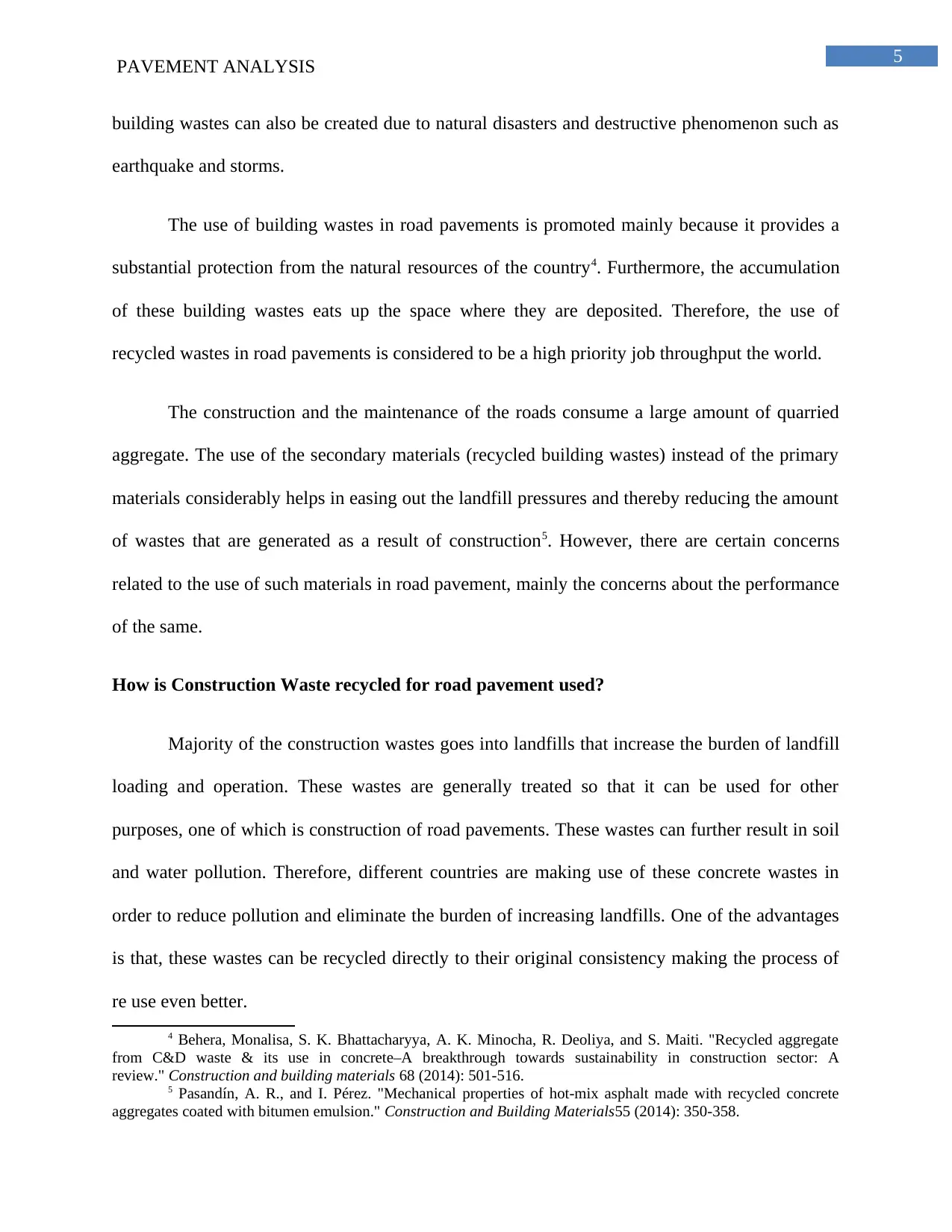
5
PAVEMENT ANALYSIS
building wastes can also be created due to natural disasters and destructive phenomenon such as
earthquake and storms.
The use of building wastes in road pavements is promoted mainly because it provides a
substantial protection from the natural resources of the country4. Furthermore, the accumulation
of these building wastes eats up the space where they are deposited. Therefore, the use of
recycled wastes in road pavements is considered to be a high priority job throughput the world.
The construction and the maintenance of the roads consume a large amount of quarried
aggregate. The use of the secondary materials (recycled building wastes) instead of the primary
materials considerably helps in easing out the landfill pressures and thereby reducing the amount
of wastes that are generated as a result of construction5. However, there are certain concerns
related to the use of such materials in road pavement, mainly the concerns about the performance
of the same.
How is Construction Waste recycled for road pavement used?
Majority of the construction wastes goes into landfills that increase the burden of landfill
loading and operation. These wastes are generally treated so that it can be used for other
purposes, one of which is construction of road pavements. These wastes can further result in soil
and water pollution. Therefore, different countries are making use of these concrete wastes in
order to reduce pollution and eliminate the burden of increasing landfills. One of the advantages
is that, these wastes can be recycled directly to their original consistency making the process of
re use even better.
4 Behera, Monalisa, S. K. Bhattacharyya, A. K. Minocha, R. Deoliya, and S. Maiti. "Recycled aggregate
from C&D waste & its use in concrete–A breakthrough towards sustainability in construction sector: A
review." Construction and building materials 68 (2014): 501-516.
5 Pasandín, A. R., and I. Pérez. "Mechanical properties of hot-mix asphalt made with recycled concrete
aggregates coated with bitumen emulsion." Construction and Building Materials55 (2014): 350-358.
PAVEMENT ANALYSIS
building wastes can also be created due to natural disasters and destructive phenomenon such as
earthquake and storms.
The use of building wastes in road pavements is promoted mainly because it provides a
substantial protection from the natural resources of the country4. Furthermore, the accumulation
of these building wastes eats up the space where they are deposited. Therefore, the use of
recycled wastes in road pavements is considered to be a high priority job throughput the world.
The construction and the maintenance of the roads consume a large amount of quarried
aggregate. The use of the secondary materials (recycled building wastes) instead of the primary
materials considerably helps in easing out the landfill pressures and thereby reducing the amount
of wastes that are generated as a result of construction5. However, there are certain concerns
related to the use of such materials in road pavement, mainly the concerns about the performance
of the same.
How is Construction Waste recycled for road pavement used?
Majority of the construction wastes goes into landfills that increase the burden of landfill
loading and operation. These wastes are generally treated so that it can be used for other
purposes, one of which is construction of road pavements. These wastes can further result in soil
and water pollution. Therefore, different countries are making use of these concrete wastes in
order to reduce pollution and eliminate the burden of increasing landfills. One of the advantages
is that, these wastes can be recycled directly to their original consistency making the process of
re use even better.
4 Behera, Monalisa, S. K. Bhattacharyya, A. K. Minocha, R. Deoliya, and S. Maiti. "Recycled aggregate
from C&D waste & its use in concrete–A breakthrough towards sustainability in construction sector: A
review." Construction and building materials 68 (2014): 501-516.
5 Pasandín, A. R., and I. Pérez. "Mechanical properties of hot-mix asphalt made with recycled concrete
aggregates coated with bitumen emulsion." Construction and Building Materials55 (2014): 350-358.
⊘ This is a preview!⊘
Do you want full access?
Subscribe today to unlock all pages.

Trusted by 1+ million students worldwide
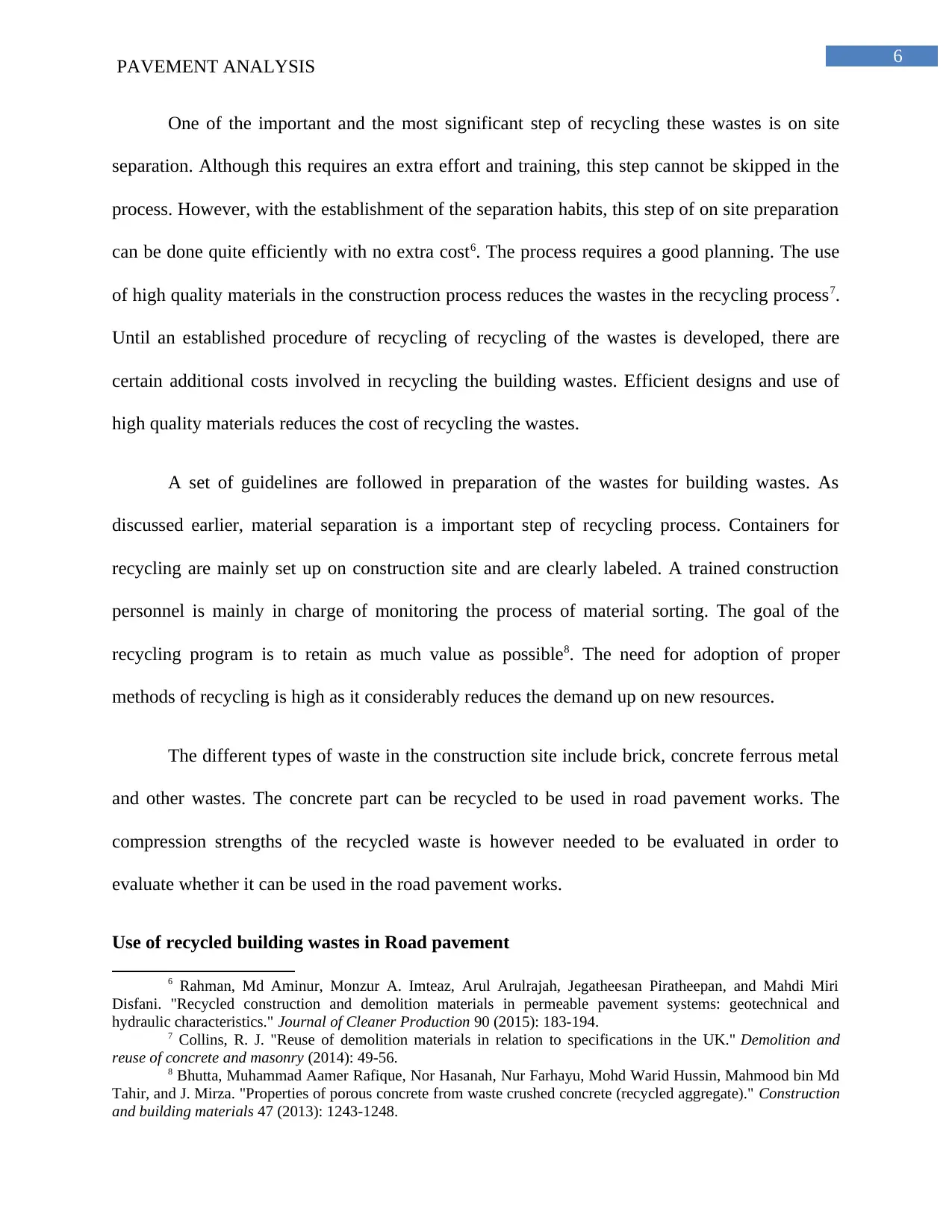
6
PAVEMENT ANALYSIS
One of the important and the most significant step of recycling these wastes is on site
separation. Although this requires an extra effort and training, this step cannot be skipped in the
process. However, with the establishment of the separation habits, this step of on site preparation
can be done quite efficiently with no extra cost6. The process requires a good planning. The use
of high quality materials in the construction process reduces the wastes in the recycling process7.
Until an established procedure of recycling of recycling of the wastes is developed, there are
certain additional costs involved in recycling the building wastes. Efficient designs and use of
high quality materials reduces the cost of recycling the wastes.
A set of guidelines are followed in preparation of the wastes for building wastes. As
discussed earlier, material separation is a important step of recycling process. Containers for
recycling are mainly set up on construction site and are clearly labeled. A trained construction
personnel is mainly in charge of monitoring the process of material sorting. The goal of the
recycling program is to retain as much value as possible8. The need for adoption of proper
methods of recycling is high as it considerably reduces the demand up on new resources.
The different types of waste in the construction site include brick, concrete ferrous metal
and other wastes. The concrete part can be recycled to be used in road pavement works. The
compression strengths of the recycled waste is however needed to be evaluated in order to
evaluate whether it can be used in the road pavement works.
Use of recycled building wastes in Road pavement
6 Rahman, Md Aminur, Monzur A. Imteaz, Arul Arulrajah, Jegatheesan Piratheepan, and Mahdi Miri
Disfani. "Recycled construction and demolition materials in permeable pavement systems: geotechnical and
hydraulic characteristics." Journal of Cleaner Production 90 (2015): 183-194.
7 Collins, R. J. "Reuse of demolition materials in relation to specifications in the UK." Demolition and
reuse of concrete and masonry (2014): 49-56.
8 Bhutta, Muhammad Aamer Rafique, Nor Hasanah, Nur Farhayu, Mohd Warid Hussin, Mahmood bin Md
Tahir, and J. Mirza. "Properties of porous concrete from waste crushed concrete (recycled aggregate)." Construction
and building materials 47 (2013): 1243-1248.
PAVEMENT ANALYSIS
One of the important and the most significant step of recycling these wastes is on site
separation. Although this requires an extra effort and training, this step cannot be skipped in the
process. However, with the establishment of the separation habits, this step of on site preparation
can be done quite efficiently with no extra cost6. The process requires a good planning. The use
of high quality materials in the construction process reduces the wastes in the recycling process7.
Until an established procedure of recycling of recycling of the wastes is developed, there are
certain additional costs involved in recycling the building wastes. Efficient designs and use of
high quality materials reduces the cost of recycling the wastes.
A set of guidelines are followed in preparation of the wastes for building wastes. As
discussed earlier, material separation is a important step of recycling process. Containers for
recycling are mainly set up on construction site and are clearly labeled. A trained construction
personnel is mainly in charge of monitoring the process of material sorting. The goal of the
recycling program is to retain as much value as possible8. The need for adoption of proper
methods of recycling is high as it considerably reduces the demand up on new resources.
The different types of waste in the construction site include brick, concrete ferrous metal
and other wastes. The concrete part can be recycled to be used in road pavement works. The
compression strengths of the recycled waste is however needed to be evaluated in order to
evaluate whether it can be used in the road pavement works.
Use of recycled building wastes in Road pavement
6 Rahman, Md Aminur, Monzur A. Imteaz, Arul Arulrajah, Jegatheesan Piratheepan, and Mahdi Miri
Disfani. "Recycled construction and demolition materials in permeable pavement systems: geotechnical and
hydraulic characteristics." Journal of Cleaner Production 90 (2015): 183-194.
7 Collins, R. J. "Reuse of demolition materials in relation to specifications in the UK." Demolition and
reuse of concrete and masonry (2014): 49-56.
8 Bhutta, Muhammad Aamer Rafique, Nor Hasanah, Nur Farhayu, Mohd Warid Hussin, Mahmood bin Md
Tahir, and J. Mirza. "Properties of porous concrete from waste crushed concrete (recycled aggregate)." Construction
and building materials 47 (2013): 1243-1248.
Paraphrase This Document
Need a fresh take? Get an instant paraphrase of this document with our AI Paraphraser
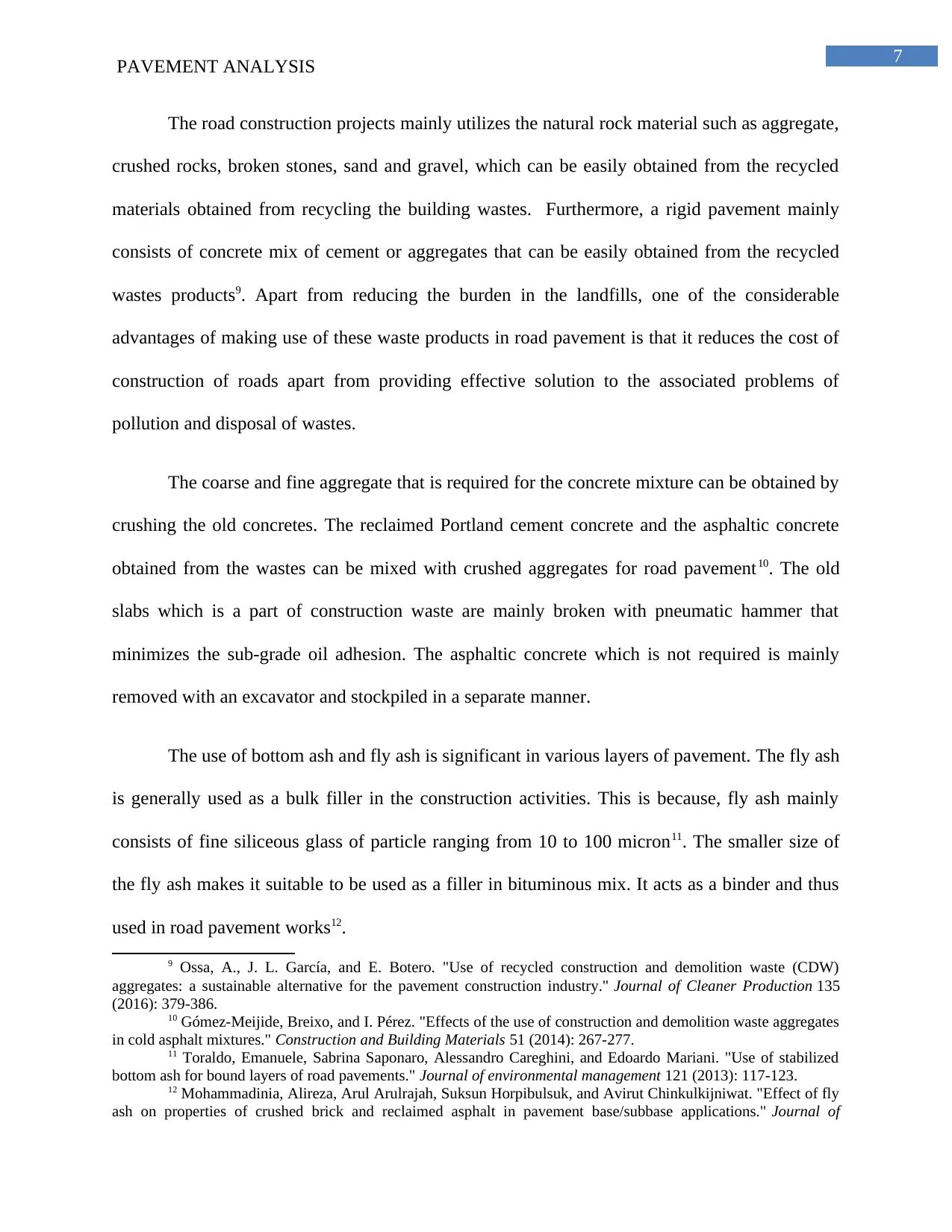
7
PAVEMENT ANALYSIS
The road construction projects mainly utilizes the natural rock material such as aggregate,
crushed rocks, broken stones, sand and gravel, which can be easily obtained from the recycled
materials obtained from recycling the building wastes. Furthermore, a rigid pavement mainly
consists of concrete mix of cement or aggregates that can be easily obtained from the recycled
wastes products9. Apart from reducing the burden in the landfills, one of the considerable
advantages of making use of these waste products in road pavement is that it reduces the cost of
construction of roads apart from providing effective solution to the associated problems of
pollution and disposal of wastes.
The coarse and fine aggregate that is required for the concrete mixture can be obtained by
crushing the old concretes. The reclaimed Portland cement concrete and the asphaltic concrete
obtained from the wastes can be mixed with crushed aggregates for road pavement10. The old
slabs which is a part of construction waste are mainly broken with pneumatic hammer that
minimizes the sub-grade oil adhesion. The asphaltic concrete which is not required is mainly
removed with an excavator and stockpiled in a separate manner.
The use of bottom ash and fly ash is significant in various layers of pavement. The fly ash
is generally used as a bulk filler in the construction activities. This is because, fly ash mainly
consists of fine siliceous glass of particle ranging from 10 to 100 micron11. The smaller size of
the fly ash makes it suitable to be used as a filler in bituminous mix. It acts as a binder and thus
used in road pavement works12.
9 Ossa, A., J. L. García, and E. Botero. "Use of recycled construction and demolition waste (CDW)
aggregates: a sustainable alternative for the pavement construction industry." Journal of Cleaner Production 135
(2016): 379-386.
10 Gómez-Meijide, Breixo, and I. Pérez. "Effects of the use of construction and demolition waste aggregates
in cold asphalt mixtures." Construction and Building Materials 51 (2014): 267-277.
11 Toraldo, Emanuele, Sabrina Saponaro, Alessandro Careghini, and Edoardo Mariani. "Use of stabilized
bottom ash for bound layers of road pavements." Journal of environmental management 121 (2013): 117-123.
12 Mohammadinia, Alireza, Arul Arulrajah, Suksun Horpibulsuk, and Avirut Chinkulkijniwat. "Effect of fly
ash on properties of crushed brick and reclaimed asphalt in pavement base/subbase applications." Journal of
PAVEMENT ANALYSIS
The road construction projects mainly utilizes the natural rock material such as aggregate,
crushed rocks, broken stones, sand and gravel, which can be easily obtained from the recycled
materials obtained from recycling the building wastes. Furthermore, a rigid pavement mainly
consists of concrete mix of cement or aggregates that can be easily obtained from the recycled
wastes products9. Apart from reducing the burden in the landfills, one of the considerable
advantages of making use of these waste products in road pavement is that it reduces the cost of
construction of roads apart from providing effective solution to the associated problems of
pollution and disposal of wastes.
The coarse and fine aggregate that is required for the concrete mixture can be obtained by
crushing the old concretes. The reclaimed Portland cement concrete and the asphaltic concrete
obtained from the wastes can be mixed with crushed aggregates for road pavement10. The old
slabs which is a part of construction waste are mainly broken with pneumatic hammer that
minimizes the sub-grade oil adhesion. The asphaltic concrete which is not required is mainly
removed with an excavator and stockpiled in a separate manner.
The use of bottom ash and fly ash is significant in various layers of pavement. The fly ash
is generally used as a bulk filler in the construction activities. This is because, fly ash mainly
consists of fine siliceous glass of particle ranging from 10 to 100 micron11. The smaller size of
the fly ash makes it suitable to be used as a filler in bituminous mix. It acts as a binder and thus
used in road pavement works12.
9 Ossa, A., J. L. García, and E. Botero. "Use of recycled construction and demolition waste (CDW)
aggregates: a sustainable alternative for the pavement construction industry." Journal of Cleaner Production 135
(2016): 379-386.
10 Gómez-Meijide, Breixo, and I. Pérez. "Effects of the use of construction and demolition waste aggregates
in cold asphalt mixtures." Construction and Building Materials 51 (2014): 267-277.
11 Toraldo, Emanuele, Sabrina Saponaro, Alessandro Careghini, and Edoardo Mariani. "Use of stabilized
bottom ash for bound layers of road pavements." Journal of environmental management 121 (2013): 117-123.
12 Mohammadinia, Alireza, Arul Arulrajah, Suksun Horpibulsuk, and Avirut Chinkulkijniwat. "Effect of fly
ash on properties of crushed brick and reclaimed asphalt in pavement base/subbase applications." Journal of
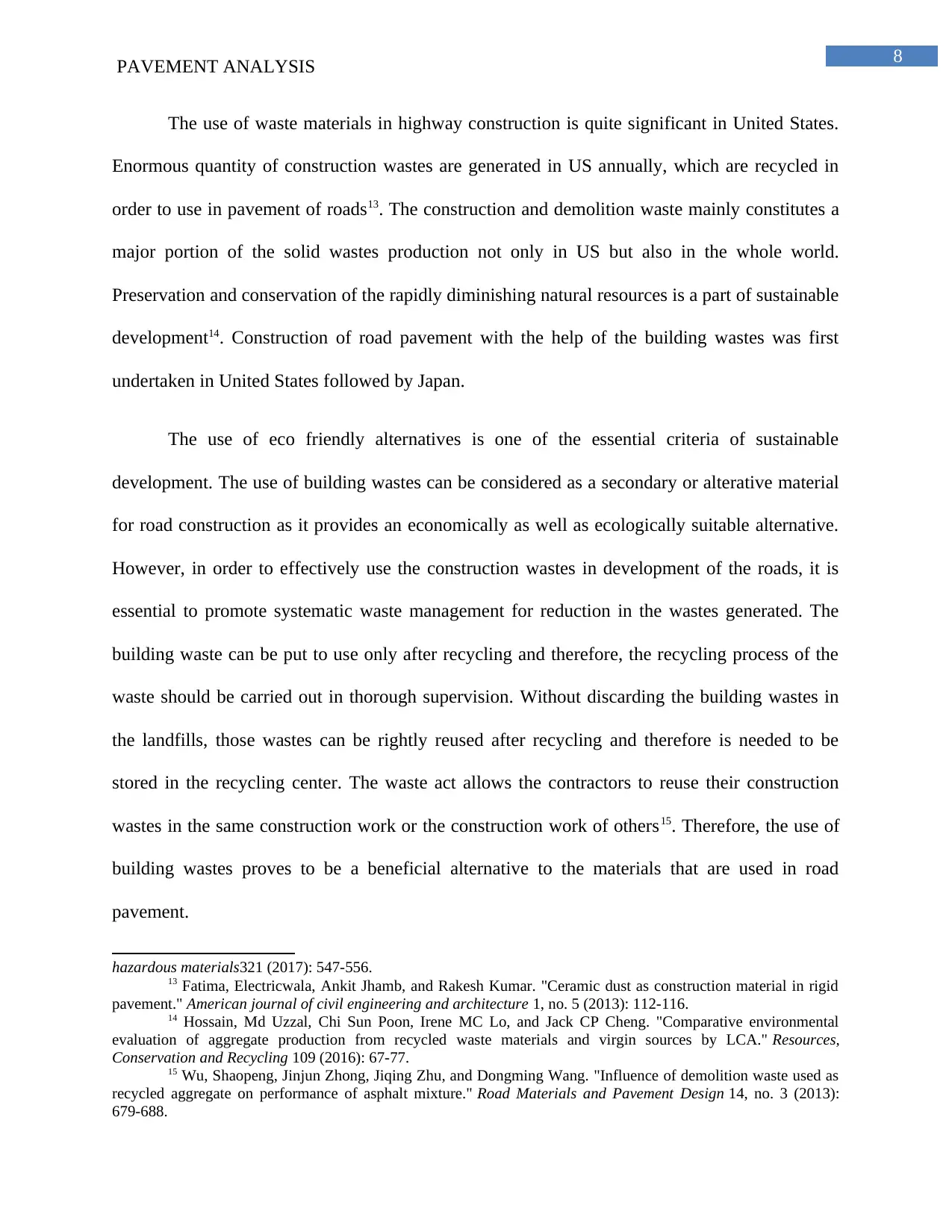
8
PAVEMENT ANALYSIS
The use of waste materials in highway construction is quite significant in United States.
Enormous quantity of construction wastes are generated in US annually, which are recycled in
order to use in pavement of roads13. The construction and demolition waste mainly constitutes a
major portion of the solid wastes production not only in US but also in the whole world.
Preservation and conservation of the rapidly diminishing natural resources is a part of sustainable
development14. Construction of road pavement with the help of the building wastes was first
undertaken in United States followed by Japan.
The use of eco friendly alternatives is one of the essential criteria of sustainable
development. The use of building wastes can be considered as a secondary or alterative material
for road construction as it provides an economically as well as ecologically suitable alternative.
However, in order to effectively use the construction wastes in development of the roads, it is
essential to promote systematic waste management for reduction in the wastes generated. The
building waste can be put to use only after recycling and therefore, the recycling process of the
waste should be carried out in thorough supervision. Without discarding the building wastes in
the landfills, those wastes can be rightly reused after recycling and therefore is needed to be
stored in the recycling center. The waste act allows the contractors to reuse their construction
wastes in the same construction work or the construction work of others15. Therefore, the use of
building wastes proves to be a beneficial alternative to the materials that are used in road
pavement.
hazardous materials321 (2017): 547-556.
13 Fatima, Electricwala, Ankit Jhamb, and Rakesh Kumar. "Ceramic dust as construction material in rigid
pavement." American journal of civil engineering and architecture 1, no. 5 (2013): 112-116.
14 Hossain, Md Uzzal, Chi Sun Poon, Irene MC Lo, and Jack CP Cheng. "Comparative environmental
evaluation of aggregate production from recycled waste materials and virgin sources by LCA." Resources,
Conservation and Recycling 109 (2016): 67-77.
15 Wu, Shaopeng, Jinjun Zhong, Jiqing Zhu, and Dongming Wang. "Influence of demolition waste used as
recycled aggregate on performance of asphalt mixture." Road Materials and Pavement Design 14, no. 3 (2013):
679-688.
PAVEMENT ANALYSIS
The use of waste materials in highway construction is quite significant in United States.
Enormous quantity of construction wastes are generated in US annually, which are recycled in
order to use in pavement of roads13. The construction and demolition waste mainly constitutes a
major portion of the solid wastes production not only in US but also in the whole world.
Preservation and conservation of the rapidly diminishing natural resources is a part of sustainable
development14. Construction of road pavement with the help of the building wastes was first
undertaken in United States followed by Japan.
The use of eco friendly alternatives is one of the essential criteria of sustainable
development. The use of building wastes can be considered as a secondary or alterative material
for road construction as it provides an economically as well as ecologically suitable alternative.
However, in order to effectively use the construction wastes in development of the roads, it is
essential to promote systematic waste management for reduction in the wastes generated. The
building waste can be put to use only after recycling and therefore, the recycling process of the
waste should be carried out in thorough supervision. Without discarding the building wastes in
the landfills, those wastes can be rightly reused after recycling and therefore is needed to be
stored in the recycling center. The waste act allows the contractors to reuse their construction
wastes in the same construction work or the construction work of others15. Therefore, the use of
building wastes proves to be a beneficial alternative to the materials that are used in road
pavement.
hazardous materials321 (2017): 547-556.
13 Fatima, Electricwala, Ankit Jhamb, and Rakesh Kumar. "Ceramic dust as construction material in rigid
pavement." American journal of civil engineering and architecture 1, no. 5 (2013): 112-116.
14 Hossain, Md Uzzal, Chi Sun Poon, Irene MC Lo, and Jack CP Cheng. "Comparative environmental
evaluation of aggregate production from recycled waste materials and virgin sources by LCA." Resources,
Conservation and Recycling 109 (2016): 67-77.
15 Wu, Shaopeng, Jinjun Zhong, Jiqing Zhu, and Dongming Wang. "Influence of demolition waste used as
recycled aggregate on performance of asphalt mixture." Road Materials and Pavement Design 14, no. 3 (2013):
679-688.
⊘ This is a preview!⊘
Do you want full access?
Subscribe today to unlock all pages.

Trusted by 1+ million students worldwide
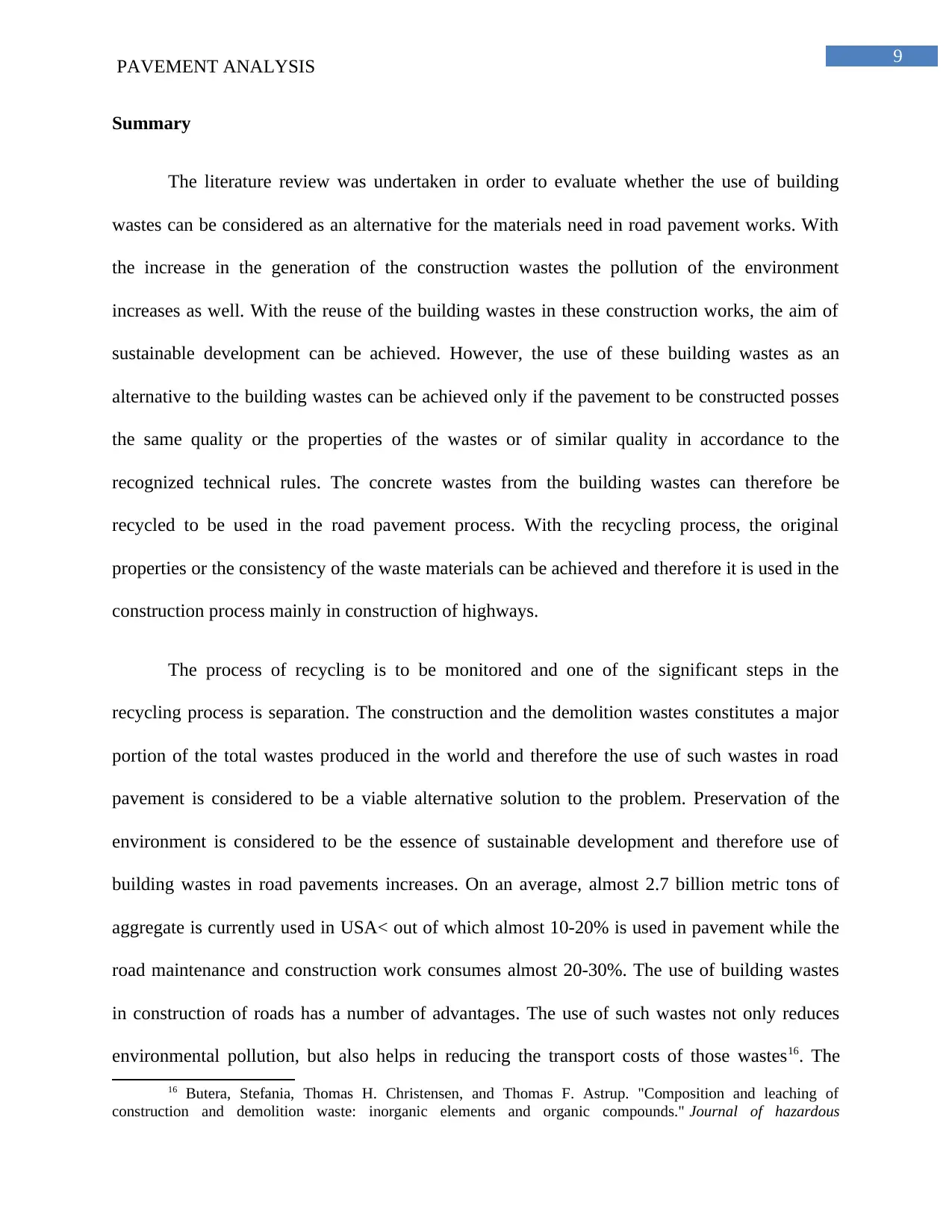
9
PAVEMENT ANALYSIS
Summary
The literature review was undertaken in order to evaluate whether the use of building
wastes can be considered as an alternative for the materials need in road pavement works. With
the increase in the generation of the construction wastes the pollution of the environment
increases as well. With the reuse of the building wastes in these construction works, the aim of
sustainable development can be achieved. However, the use of these building wastes as an
alternative to the building wastes can be achieved only if the pavement to be constructed posses
the same quality or the properties of the wastes or of similar quality in accordance to the
recognized technical rules. The concrete wastes from the building wastes can therefore be
recycled to be used in the road pavement process. With the recycling process, the original
properties or the consistency of the waste materials can be achieved and therefore it is used in the
construction process mainly in construction of highways.
The process of recycling is to be monitored and one of the significant steps in the
recycling process is separation. The construction and the demolition wastes constitutes a major
portion of the total wastes produced in the world and therefore the use of such wastes in road
pavement is considered to be a viable alternative solution to the problem. Preservation of the
environment is considered to be the essence of sustainable development and therefore use of
building wastes in road pavements increases. On an average, almost 2.7 billion metric tons of
aggregate is currently used in USA< out of which almost 10-20% is used in pavement while the
road maintenance and construction work consumes almost 20-30%. The use of building wastes
in construction of roads has a number of advantages. The use of such wastes not only reduces
environmental pollution, but also helps in reducing the transport costs of those wastes16. The
16 Butera, Stefania, Thomas H. Christensen, and Thomas F. Astrup. "Composition and leaching of
construction and demolition waste: inorganic elements and organic compounds." Journal of hazardous
PAVEMENT ANALYSIS
Summary
The literature review was undertaken in order to evaluate whether the use of building
wastes can be considered as an alternative for the materials need in road pavement works. With
the increase in the generation of the construction wastes the pollution of the environment
increases as well. With the reuse of the building wastes in these construction works, the aim of
sustainable development can be achieved. However, the use of these building wastes as an
alternative to the building wastes can be achieved only if the pavement to be constructed posses
the same quality or the properties of the wastes or of similar quality in accordance to the
recognized technical rules. The concrete wastes from the building wastes can therefore be
recycled to be used in the road pavement process. With the recycling process, the original
properties or the consistency of the waste materials can be achieved and therefore it is used in the
construction process mainly in construction of highways.
The process of recycling is to be monitored and one of the significant steps in the
recycling process is separation. The construction and the demolition wastes constitutes a major
portion of the total wastes produced in the world and therefore the use of such wastes in road
pavement is considered to be a viable alternative solution to the problem. Preservation of the
environment is considered to be the essence of sustainable development and therefore use of
building wastes in road pavements increases. On an average, almost 2.7 billion metric tons of
aggregate is currently used in USA< out of which almost 10-20% is used in pavement while the
road maintenance and construction work consumes almost 20-30%. The use of building wastes
in construction of roads has a number of advantages. The use of such wastes not only reduces
environmental pollution, but also helps in reducing the transport costs of those wastes16. The
16 Butera, Stefania, Thomas H. Christensen, and Thomas F. Astrup. "Composition and leaching of
construction and demolition waste: inorganic elements and organic compounds." Journal of hazardous
Paraphrase This Document
Need a fresh take? Get an instant paraphrase of this document with our AI Paraphraser
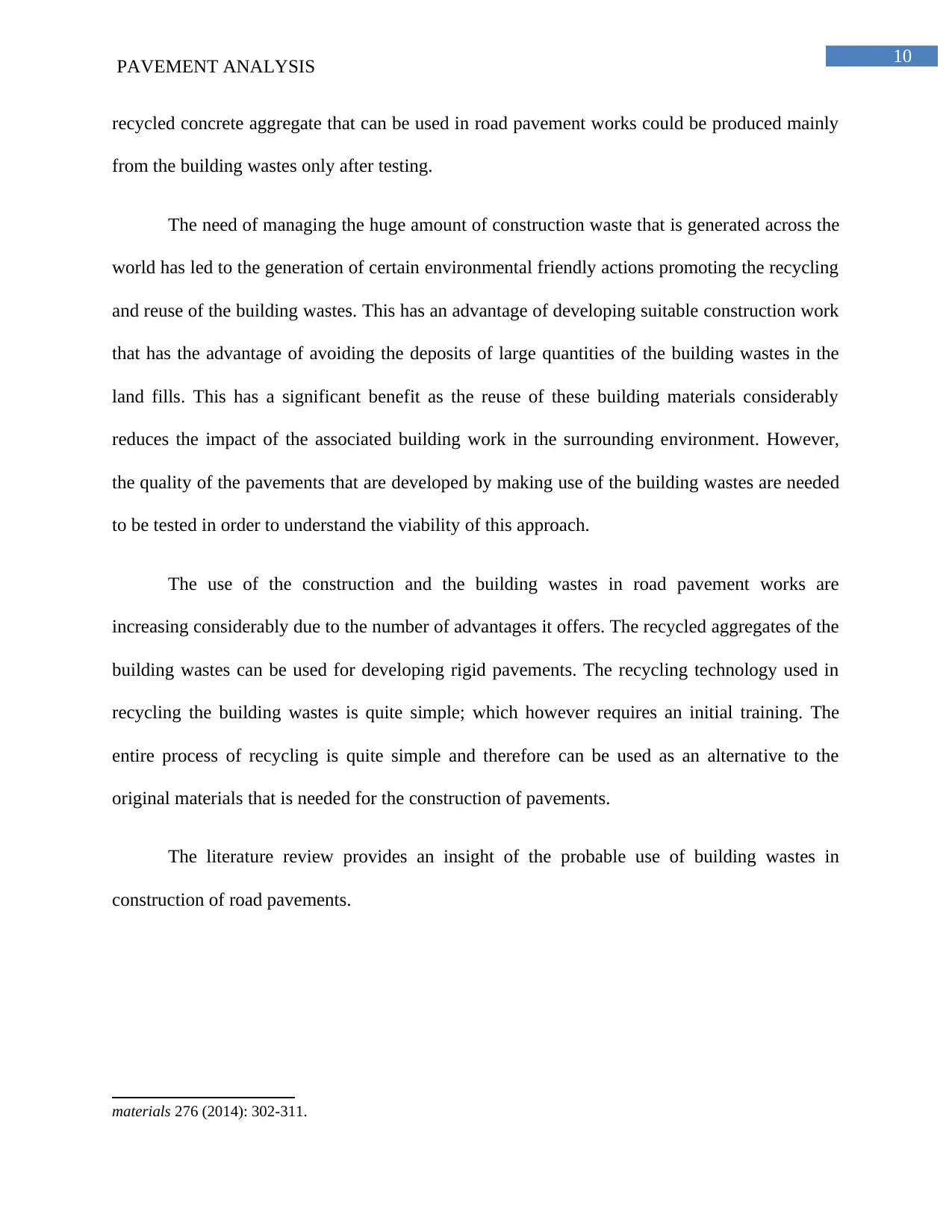
10
PAVEMENT ANALYSIS
recycled concrete aggregate that can be used in road pavement works could be produced mainly
from the building wastes only after testing.
The need of managing the huge amount of construction waste that is generated across the
world has led to the generation of certain environmental friendly actions promoting the recycling
and reuse of the building wastes. This has an advantage of developing suitable construction work
that has the advantage of avoiding the deposits of large quantities of the building wastes in the
land fills. This has a significant benefit as the reuse of these building materials considerably
reduces the impact of the associated building work in the surrounding environment. However,
the quality of the pavements that are developed by making use of the building wastes are needed
to be tested in order to understand the viability of this approach.
The use of the construction and the building wastes in road pavement works are
increasing considerably due to the number of advantages it offers. The recycled aggregates of the
building wastes can be used for developing rigid pavements. The recycling technology used in
recycling the building wastes is quite simple; which however requires an initial training. The
entire process of recycling is quite simple and therefore can be used as an alternative to the
original materials that is needed for the construction of pavements.
The literature review provides an insight of the probable use of building wastes in
construction of road pavements.
materials 276 (2014): 302-311.
PAVEMENT ANALYSIS
recycled concrete aggregate that can be used in road pavement works could be produced mainly
from the building wastes only after testing.
The need of managing the huge amount of construction waste that is generated across the
world has led to the generation of certain environmental friendly actions promoting the recycling
and reuse of the building wastes. This has an advantage of developing suitable construction work
that has the advantage of avoiding the deposits of large quantities of the building wastes in the
land fills. This has a significant benefit as the reuse of these building materials considerably
reduces the impact of the associated building work in the surrounding environment. However,
the quality of the pavements that are developed by making use of the building wastes are needed
to be tested in order to understand the viability of this approach.
The use of the construction and the building wastes in road pavement works are
increasing considerably due to the number of advantages it offers. The recycled aggregates of the
building wastes can be used for developing rigid pavements. The recycling technology used in
recycling the building wastes is quite simple; which however requires an initial training. The
entire process of recycling is quite simple and therefore can be used as an alternative to the
original materials that is needed for the construction of pavements.
The literature review provides an insight of the probable use of building wastes in
construction of road pavements.
materials 276 (2014): 302-311.
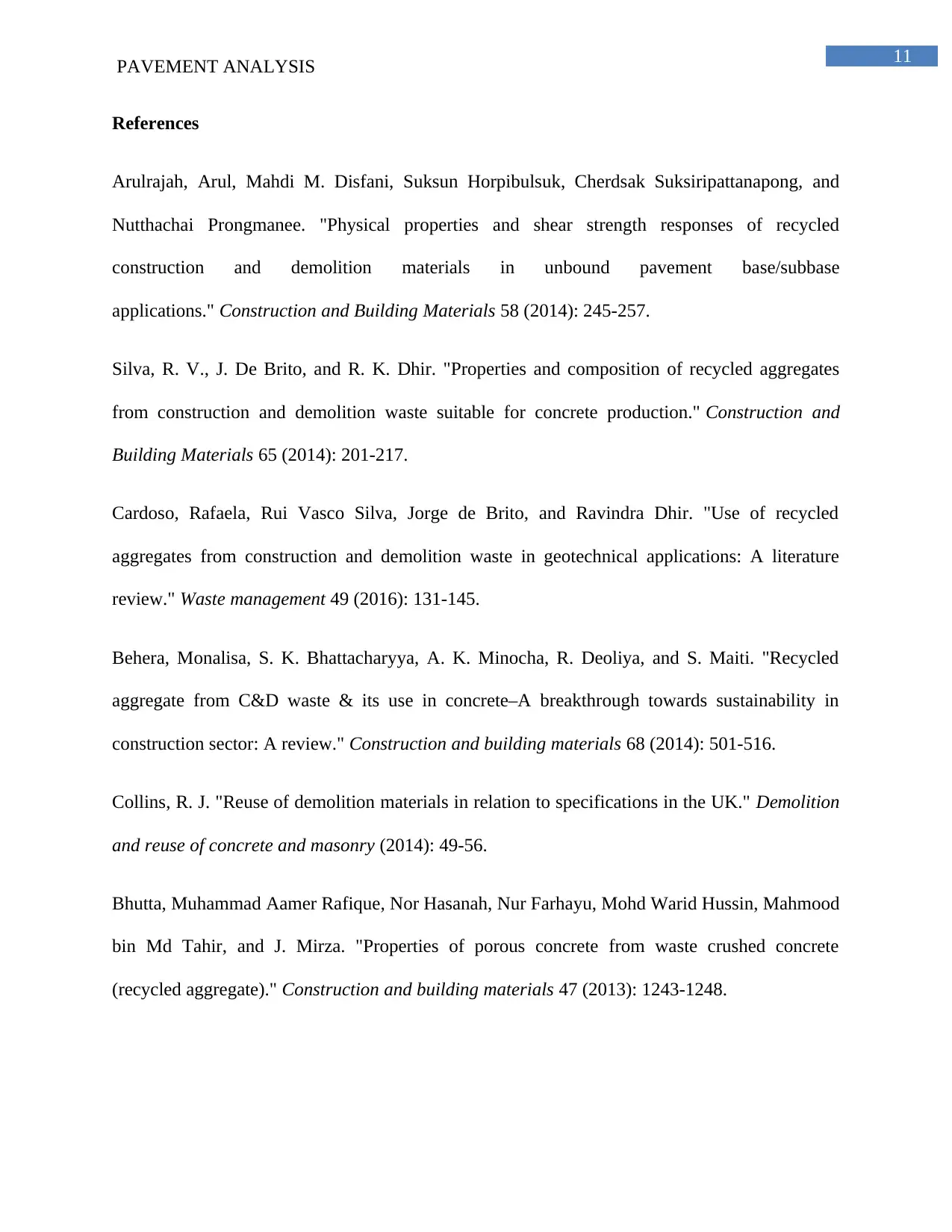
11
PAVEMENT ANALYSIS
References
Arulrajah, Arul, Mahdi M. Disfani, Suksun Horpibulsuk, Cherdsak Suksiripattanapong, and
Nutthachai Prongmanee. "Physical properties and shear strength responses of recycled
construction and demolition materials in unbound pavement base/subbase
applications." Construction and Building Materials 58 (2014): 245-257.
Silva, R. V., J. De Brito, and R. K. Dhir. "Properties and composition of recycled aggregates
from construction and demolition waste suitable for concrete production." Construction and
Building Materials 65 (2014): 201-217.
Cardoso, Rafaela, Rui Vasco Silva, Jorge de Brito, and Ravindra Dhir. "Use of recycled
aggregates from construction and demolition waste in geotechnical applications: A literature
review." Waste management 49 (2016): 131-145.
Behera, Monalisa, S. K. Bhattacharyya, A. K. Minocha, R. Deoliya, and S. Maiti. "Recycled
aggregate from C&D waste & its use in concrete–A breakthrough towards sustainability in
construction sector: A review." Construction and building materials 68 (2014): 501-516.
Collins, R. J. "Reuse of demolition materials in relation to specifications in the UK." Demolition
and reuse of concrete and masonry (2014): 49-56.
Bhutta, Muhammad Aamer Rafique, Nor Hasanah, Nur Farhayu, Mohd Warid Hussin, Mahmood
bin Md Tahir, and J. Mirza. "Properties of porous concrete from waste crushed concrete
(recycled aggregate)." Construction and building materials 47 (2013): 1243-1248.
PAVEMENT ANALYSIS
References
Arulrajah, Arul, Mahdi M. Disfani, Suksun Horpibulsuk, Cherdsak Suksiripattanapong, and
Nutthachai Prongmanee. "Physical properties and shear strength responses of recycled
construction and demolition materials in unbound pavement base/subbase
applications." Construction and Building Materials 58 (2014): 245-257.
Silva, R. V., J. De Brito, and R. K. Dhir. "Properties and composition of recycled aggregates
from construction and demolition waste suitable for concrete production." Construction and
Building Materials 65 (2014): 201-217.
Cardoso, Rafaela, Rui Vasco Silva, Jorge de Brito, and Ravindra Dhir. "Use of recycled
aggregates from construction and demolition waste in geotechnical applications: A literature
review." Waste management 49 (2016): 131-145.
Behera, Monalisa, S. K. Bhattacharyya, A. K. Minocha, R. Deoliya, and S. Maiti. "Recycled
aggregate from C&D waste & its use in concrete–A breakthrough towards sustainability in
construction sector: A review." Construction and building materials 68 (2014): 501-516.
Collins, R. J. "Reuse of demolition materials in relation to specifications in the UK." Demolition
and reuse of concrete and masonry (2014): 49-56.
Bhutta, Muhammad Aamer Rafique, Nor Hasanah, Nur Farhayu, Mohd Warid Hussin, Mahmood
bin Md Tahir, and J. Mirza. "Properties of porous concrete from waste crushed concrete
(recycled aggregate)." Construction and building materials 47 (2013): 1243-1248.
⊘ This is a preview!⊘
Do you want full access?
Subscribe today to unlock all pages.

Trusted by 1+ million students worldwide
1 out of 14
Related Documents
Your All-in-One AI-Powered Toolkit for Academic Success.
+13062052269
info@desklib.com
Available 24*7 on WhatsApp / Email
![[object Object]](/_next/static/media/star-bottom.7253800d.svg)
Unlock your academic potential
Copyright © 2020–2025 A2Z Services. All Rights Reserved. Developed and managed by ZUCOL.





